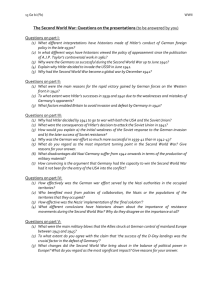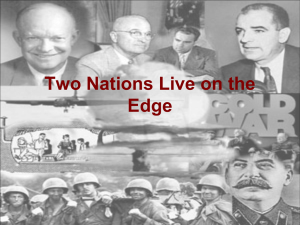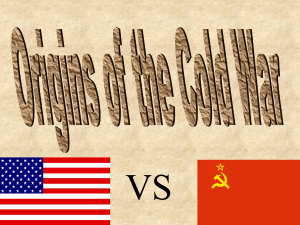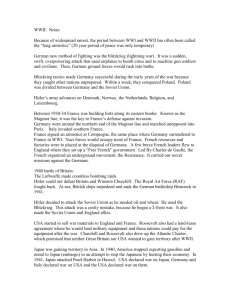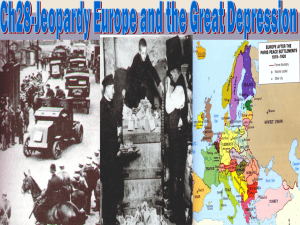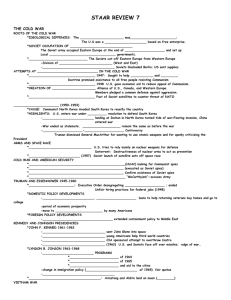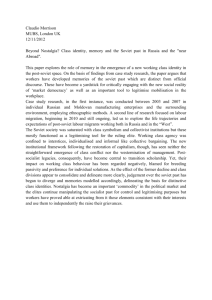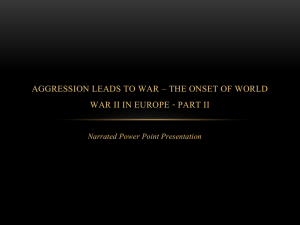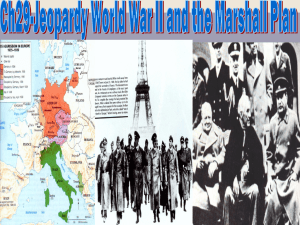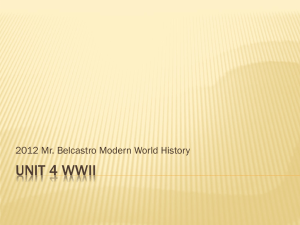The Soviet Union in the Second World War
advertisement
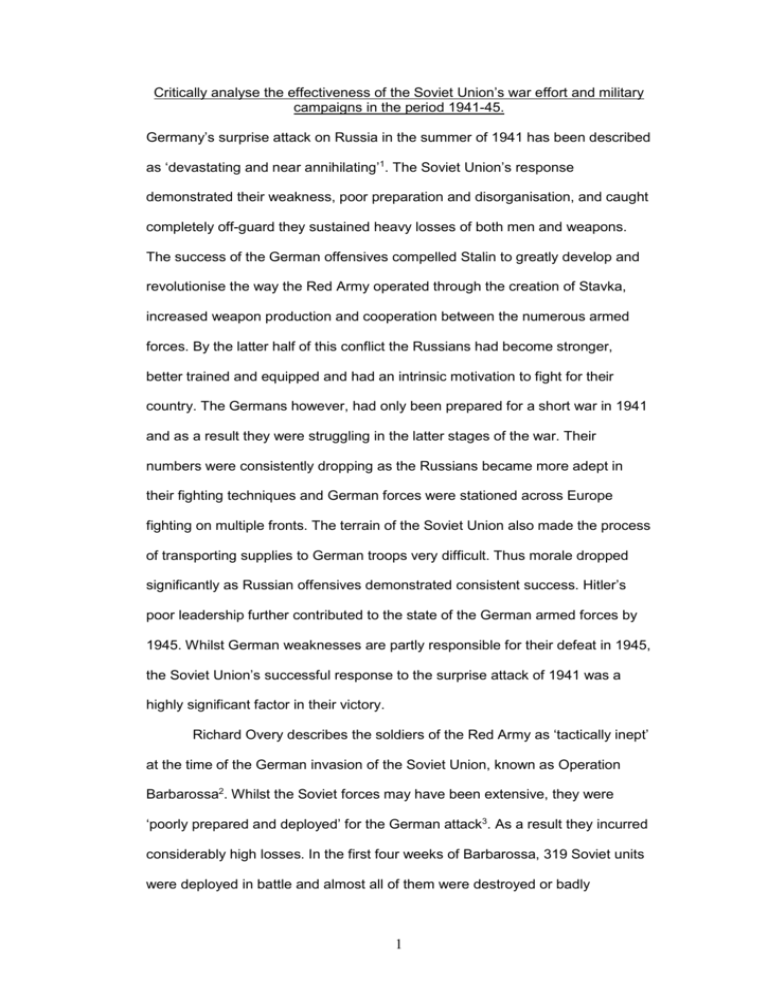
Critically analyse the effectiveness of the Soviet Union’s war effort and military campaigns in the period 1941-45. Germany’s surprise attack on Russia in the summer of 1941 has been described as ‘devastating and near annihilating’1. The Soviet Union’s response demonstrated their weakness, poor preparation and disorganisation, and caught completely off-guard they sustained heavy losses of both men and weapons. The success of the German offensives compelled Stalin to greatly develop and revolutionise the way the Red Army operated through the creation of Stavka, increased weapon production and cooperation between the numerous armed forces. By the latter half of this conflict the Russians had become stronger, better trained and equipped and had an intrinsic motivation to fight for their country. The Germans however, had only been prepared for a short war in 1941 and as a result they were struggling in the latter stages of the war. Their numbers were consistently dropping as the Russians became more adept in their fighting techniques and German forces were stationed across Europe fighting on multiple fronts. The terrain of the Soviet Union also made the process of transporting supplies to German troops very difficult. Thus morale dropped significantly as Russian offensives demonstrated consistent success. Hitler’s poor leadership further contributed to the state of the German armed forces by 1945. Whilst German weaknesses are partly responsible for their defeat in 1945, the Soviet Union’s successful response to the surprise attack of 1941 was a highly significant factor in their victory. Richard Overy describes the soldiers of the Red Army as ‘tactically inept’ at the time of the German invasion of the Soviet Union, known as Operation Barbarossa2. Whilst the Soviet forces may have been extensive, they were ‘poorly prepared and deployed’ for the German attack3. As a result they incurred considerably high losses. In the first four weeks of Barbarossa, 319 Soviet units were deployed in battle and almost all of them were destroyed or badly 1 damaged due to their lack of ‘air cover, adequate weapons or intelligence’4. By contrast, the Germans proved to be initially very strong, executing their surprise attack efficiently and advancing rapidly inside the Soviet Union. The speed of their advance is said to have ‘overwhelmed the Soviet supply system’, as they progressed along a two thousand kilometre front and conquered the former Baltic republics of White Russia and the Ukraine5, inflicting heavy casualties in the process. Alan Clark refers to the German soldiers at this time as ‘the most experienced and highly trained soldiers in the world’6. In order to have any hope of survival, possibly even victory, it was clear to Stalin that the Red Army needed to be ‘profoundly transformed’7. This led him to reorganise the army through the creation of Stavka, a strategic high command8. Resources were mobilised, industries were moved eastwards and Stalin focused on mobilising Russian citizens through patriotism rather than communism9. The subsequent offensives illustrated both the transformation of the army and the potential for further improvement. By 1944, the Soviet forces had demonstrated their enhanced operational capability by pushing the Germans ‘back across Russia, White Russia and the Ukraine in an impressive series of offensives’10. The Soviet invasion of Manchuria in August 1945 highlighted the full extent of the army’s transformation. The Soviets had large numbers of tanks, guns and aircraft, were better trained and executed rapid encirclements of their opponents with the aid of airborne detachments to secure vital positions11. So how did they achieve this radical transformation in the space of only four years? Soviet soldiers were naturally adept at concealment12 and used this to great advantage against the German armies. This policy of deception was known as ‘Maskirovka’ and the first major example of its use was in the Soviet counter-attack at Stalingrad in November 194213. The Red Army also developed good cooperation between their armour, artillery and infantry divisions, enabling 2 them to successfully execute encirclements of the Germans14. The growth and vast improvement of the Soviet Air Force also revolutionised the way the Soviets fought battles and became ‘an integral part of Soviet offensive operations’15. Whilst the German Luftwaffe had lost its advantage by the Battle of Kursk in 1943, the Soviets were able ‘to field 8,300 combat aircraft’16 and their ability to do so was greatly enhanced by the development of a more effective radio communication system17. In addition to the development of aircraft, the Soviets significantly increased the number and quality of their tanks and by January 1945, the Soviets utilised large numbers of tanks in their conquest of Poland18. The Soviets were not always successful in their offensives as their breakthrough attempt near Kharkov demonstrated in May 1942, when their failure led to encirclement by German forces19. In November of the same year, Operation Mars failed and was covered up by the Soviets20. However, their ability to mount such offensives was vastly improved, and to some extent made possible, by more and better quality supplies. The Soviet Union benefited from an abundance of raw materials21 which enabled it to manufacture greater numbers of improved equipment. Clark describes the Russians as ‘superior’ in ‘the key figures of tank strength and field artillery’22 and refers to the German’s ‘static or declined’ firepower strength in comparison with the Soviet’s growing strength23. The Soviets’ use of simple weapons enabled them to produce weapons in far greater number and often of better quality24. The Soviet war effort was undoubtedly assisted by ‘large quantities of Angle-American supplies’25 and this aid programme was highly significant in ‘maintaining the Soviet war economy’26. The Americans also provided trucks which enabled the Soviets to ‘operationalize’ their offensives27. Although some historians cite this ‘production battle’ as the dominant determining factor in the outcome of the conflict, I think this observation misses some vital contributory factors, several of 3 which are discussed in this essay, and cannot be held solely responsible for the outcome. In addition to increased aid and supplies, the mobilisation of reserves was vital to the Soviet war effort and often proved instrumental throughout the conflict. During Operation Barabrossa, ‘over a million men’ were successfully mobilised and armed before the end of July 194128. Initial German successes could not be sustained due to the sheer number of reserves deployed to support the Soviet forces29. Partisans were mobilised to ‘fight for Mother Russia’30 and proved invaluable in gathering information about the German enemy31. The motivation for the partisans and Russian soldiers themselves was crucial in sustaining the war effort and marked them apart from the Germans. In battles for cities such as Leningrad and Stalingrad, the Soviets were fighting for their country and their homes whilst the Germans had little motivation beyond ‘postponing death’32. Stalin manipulated this by appealing to ‘popular patriotism rather than revolutionary zeal’ and made references in his speeches to great Russian heroes in order to rally the Soviets to fight33. The success of this can be seen in the 159,000 citizens who joined the Leningrad volunteers and the 120,000 volunteers in Moscow34. Paul Adair describes the Russian soldiers as ‘the greatest asset that the Red Army possessed’35 and their ongoing strength and resistance in extreme circumstances perplexed the German soldiers36. Clark uses the metaphor of a Bear to illustrate the Germans’ view of Russia, ‘the Bear was dead, but he would not lie down’37. The sheer size of the Soviet Union and its seemingly endless supplies of ‘space, manpower, physical toughness and patriotism’ made it very difficult for the Germans to ultimately defeat it38. Clark argues that Russia’s ‘sheer weight of flesh and metal would guarantee its victory in the end’39 and the Soviet superiority of 3:1 in men and 10:1 in tanks in June 1944 supports this argument. The German Army Group Centre had 800,000 men and 500 tanks to 4 the Red Army’s 2,500,000 men and 4,000 tanks40. Despite the strength of the German invading force, the ‘vastness of Russia’ had once again ‘drained an invader of energy’41. Therefore we must ask, why did arguably the strongest force ever to invade Russia fail? Despite their initial successes and rapid advancement into the Soviet Union, the Germans were only prepared for a short war and were ‘underequipped and inable to sustain’ a long campaign42. The battle of Moscow marked the German’s first major setback because, as Adair argues, they were ‘ill-prepared for other than a short summer campaign’43 and the winter weather conditions brought several problems for them. The ‘attritional character’44 of the conflict meant that by June 1944, the German army began to ‘feel the cumulative effect of its losses’45, whilst the Soviets appeared to be growing in strength. The German army was significantly under equipped for the conditions they were fighting in and this was one of four key factors in their defeat. Jeremy Black claims the Germans lacked ‘sufficient manpower, artillery and supplies’46, and ill-prepared for the extent of the conflict they were undertaking, basic supplies of ‘food, ammunition, auxiliary services’ were drastically running out in the later stages of war47. The harsh winters benefited the Soviets who were ‘well-equipped to operate in bitterly cold weather’48, and this enabled them to mount successful counter-attacks49. The Germans however were greatly disadvantaged by these conditions as mud and temperatures as low as –25°C slowed them down and made them vulnerable to Soviet offensives50. Secondly, the Germans greatly underestimated their Soviet enemy. Overy argues that the ‘remarkable revival of Soviet military manpower’ at Leningrad was a more significant problem for the Germans than the winter weather conditions51. The resistance of the Russians seemed to be ‘as tough as it had been at the start of the campaign’52 and Clark makes reference to a 5 widespread feeling of uneasiness among the German troops, who began to think they were fighting ‘something of almost super-natural strength and resilience’53. As well as fighting an enemy who appeared to only grow in strength and resistance, the Germans found themselves preoccupied with fighting on multiple fronts as ‘operations in Italy and the threat of a cross-Channel invasion’ meant they could not provide adequate strength on the Eastern Front54. These other operations drained vital men, weapons and supplies and in June 1944, German accounts of the Soviet ‘Operation Bagration’ show that few German aircraft were available to ‘provide tactical air support’ and ‘deter Soviet ground attack aircraft’55, leading to a devastating German defeat. Lastly, Hitler’s poor leadership was considerably detrimental to the German war campaign and Adair cites his personal influence on the war as ‘entirely malignant’ and contributory to ‘the catastrophic defeat of Germany’56. Clark refers to his inconsistency in directing the German campaign57 whilst Black generally views Hitler as a ‘seriously flawed commander’58 and holds him accountable for the German defeat at Stalingrad in 1943 due to his poor military direction59. Whilst the Soviets were initially weak and insufficiently prepared for Germany’s shrewd surprise attack on 22nd June 194160, Stalin’s reorganisation of the Red Army was successful and instrumental in the Soviet’s eventual victory. Although every operation from the point of reorganisation was not successful, as Operation Mars in November 1942 demonstrated61, the Soviets did become a powerful force to contend with and were marked by their stubborn resistant fighting style. Germany’s ill preparedness for a long war in unfamiliar climatic conditions and Hitler’s questionable leadership are important considerations in the examination of their defeat. However, the Soviet Union’s military effort in the latter period of the war made the outcome far from certain. 6 Although the Russians may not have outfought the Germans, as we must consider that the Germans were fighting on multiple fronts and therefore only a weakened forced was available for the Eastern Front, they did mount a strong, successful military counterforce to the Germans to win ‘the greatest and longest land battle which mankind has ever fought’62. Bibliography Adair, Paul, Hitler’s Greatest Defeat: The Collapse of Army Group Centre, June 1944 (London, 2000) Black, Jeremy, The Age of Total War, 1860-1945 (Westport, 2006), pp.121-53 Black, Jeremy, Warfare in the Western World 1882-1975 (Chesham, 2002) Boyd, Alexander, ‘The Soviet Air Force’ in John Erickson and E.J. Feuchtwanger (eds), Soviet Military Power and Performance (London, 1979), pp.88-97 Clark, Alan, Barbarossa: The Russian-German Conflict 1941-1945 (London, 1996) Erickson, John, ‘The Soviet Military System: Doctrine, Technology and Style’ in John Erickson and E.J. Feuchtwanger (eds), Soviet Military Power and Performance (London, 1979), pp.18-44 Hobsbawm, Eric, The Age of Extremes: 1914 – 1991 (London, 1995) Overy, Richard, Russia’s War (London, 1998) John Erickson, ‘The Soviet Military System’ in John Erickson and E.J. Feuchtwanger (eds), Soviet Military Power and Performance (London, 1979), p20. 2 Richard Overy, Russia’s War (London, 1998), p.87. 3 Jeremy Black, Warfare in the Western World 1882-1975 (Chesham, 2002), p.100. 4 Overy, Russia’s War, pp.76-7. 5 Black, Warfare in the Western World, p.100. 6 Alan Clark, Barbarossa: The Russian-German Conflict 1941-1945 (London, 1996), p.149. 7 Overy, Russia’s War, p.187. 8 Black, Warfare in the Western World, p.101. 9 Black, Warfare in the Western World, p.101. 10 Black, Warfare in the Western World, p.108. 11 Black, Warfare in the Western World, p.110. 12 Overy, Russia’s War, p.87. 13 Paul Adair, Hitler’s Greatest Defeat: The Collapse of Army Group Centre, June 1944 (London, 2000), p.57. 14 Jeremy Black, The Age of Total War, 1860-1945 (Westport, 2006), p.131. 15 Adair, Hitler’s Greatest Defeat, p.42. 16 Alexander Boyd, ‘The Soviet Air Force’ in John Erickson and E.J. Feuchtwanger (eds), Soviet Military Power and Performance (London, 1979), p.91. 17 Overy, Russia’s War, p.177. 18 Black, Warfare in the Western World, p.114. 1 7 19 Black, Warfare in the Western World, p.102. Black, Warfare in the Western World, p.114. 21 Adair, Hitler’s Greatest Defeat, p.169. 22 Clark, Barbarossa, p.41. 23 Clark, Barbarossa, p.372. 24 Black, Warfare in the Western World, p.119. 25 Black, Warfare in the Western World, p.120. 26 Clark, Barbarossa, p.371. 27 Black, The Age of Total War, p.131. 28 Clark, Barbarossa, p.43. 29 Black, Warfare in the Western World, p.112. 30 Adair, Hitler’s Greatest Defeat, p.71. 31 Adair, Hitler’s Greatest Defeat, p.75. 32 Overy, Russia’s War, p.183. 33 Overy, Russia’s War, p.79. 34 Overy, Russia’s War, p.80. 35 Adair, Hitler’s Greatest Defeat, p.43. 36 Clark, Barbarossa, p.54. 37 Clark, Barbarossa, p.145. 38 Eric Hobsbawm, The Age of Extremes: 1914 – 1991 (London, 1995), p.40. 39 Clark, Barbarossa, p.37. 40 Adair, Hitler’s Greatest Defeat, p.85-6. 41 Black, Warfare in the Western World, p.100. 42 Hobsbawm, The Age of Extremes, p.40. 43 Adair, Hitler’s Greatest Defeat, p.10. 44 Black, The Age of Total War, p.132. 45 Adair, Hitler’s Greatest Defeat, p.36. 46 Black, Warfare in the Western World, p.113. 47 Clark, Barbarossa, p.78. 48 Adair, Hitler’s Greatest Defeat, p.29. 49 Black, Warfare in the Western World, p.100. 50 Adair, Hitler’s Greatest Defeat, p.29. 51 Overy, Russia’s War, p.118. 52 Clark, Barbarossa, p.80. 53 Clark, Barbarossa, p.147. 54 Overy, Russia’s War, p.217. 55 Adair, Hitler’s Greatest Defeat, p.170. 56 Adair, Hitler’s Greatest Defeat, p.23. 57 Clark, Barbarossa, p.374. 58 Black, The Age of Total War, p.123. 59 Black, Warfare in the Western World, p.104. 60 Clark, Barbarossa, p.44. 61 Black, Warfare in the Western World, p.114. 62 Clark, Barbarossa, preface 20 8
